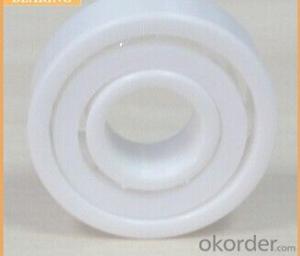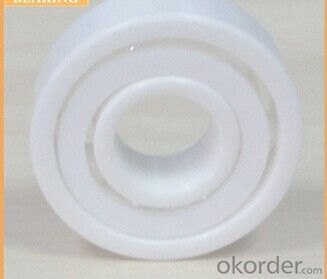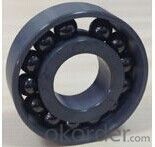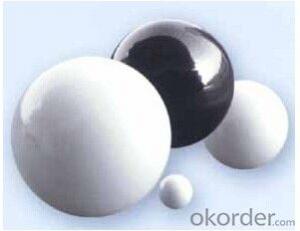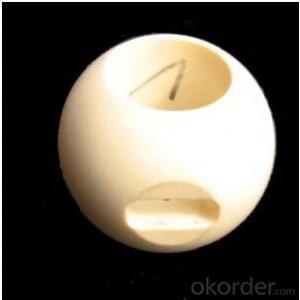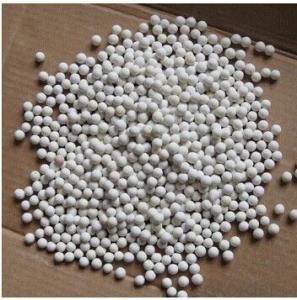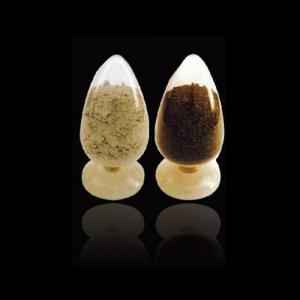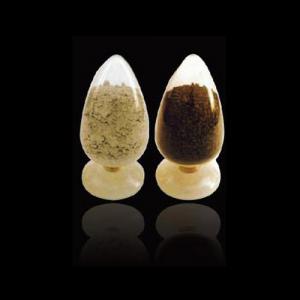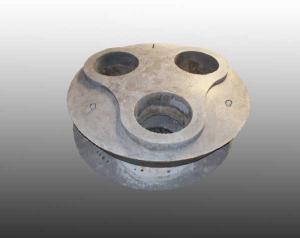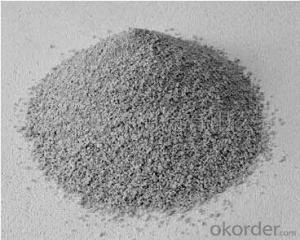Monolithic Refractories for Iron and Steel Industry High Performance Ceramic Ball Bearing
- Loading Port:
- Qingdao
- Payment Terms:
- TT OR LC
- Min Order Qty:
- 500 pc
- Supply Capability:
- 2000 pc/month
OKorder Service Pledge
Quality Product, Order Online Tracking, Timely Delivery
OKorder Financial Service
Credit Rating, Credit Services, Credit Purchasing
You Might Also Like
Specifications
Ceramic Ball Bearing
1,Low noise
2,Competitive Price
3,Quick Delivery,Good Service
4,ISO9001:2000
.Full ceramic bearing made with ZrO2 have excellent performance as special electrical and magnetism,wear and corrsion resistance,lubrication and maintance free when working,especiall high and low-temperature application,etc.,could be used in awful environment and specially condition,
2.The rings and balls: full ceramic materia:ZrO2
- Q: How do monolithic refractories withstand high temperatures and thermal cycling?
- Monolithic refractories are designed to withstand high temperatures and thermal cycling due to their unique composition and structural characteristics. Firstly, monolithic refractories are made from high-quality raw materials, such as alumina, silica, and magnesia, which have excellent thermal properties. These materials possess high melting points and low thermal conductivity, allowing them to retain their strength and integrity even at extreme temperatures. Moreover, monolithic refractories are typically engineered to have a dense and compact microstructure. This dense structure prevents the penetration of heat and gases, thus minimizing thermal shock and preventing the formation of cracks. Additionally, the compact microstructure enhances the refractory's thermal conductivity, enabling it to efficiently distribute and dissipate heat. Furthermore, monolithic refractories are often formulated with special additives and bonding agents that enhance their resistance to thermal cycling. These additives can improve the refractory's thermal expansion properties, allowing it to expand and contract without cracking or spalling during rapid temperature changes. Additionally, certain bonding agents can provide a degree of flexibility to the refractory, enabling it to accommodate thermal stresses without compromising its structural integrity. In addition to the inherent characteristics of monolithic refractories, proper installation techniques also play a crucial role in their ability to withstand high temperatures and thermal cycling. The refractory must be carefully applied and cured to ensure uniformity and minimize the formation of internal stresses. Adequate curing and heat treatment processes help to develop a strong and durable bond between the refractory and the substrate, enhancing its resistance to thermal shock and cyclic thermal loading. Overall, monolithic refractories are engineered to withstand high temperatures and thermal cycling through their composition, microstructure, and installation techniques. These factors work in synergy to provide the refractory with excellent thermal conductivity, resistance to thermal shock, and the ability to expand and contract without compromising its structural integrity.
- Q: How do monolithic refractories contribute to the overall efficiency of ladles and tundishes?
- There are several ways in which monolithic refractories greatly improve the effectiveness of ladles and tundishes. Initially, the exceptional thermal insulation properties of monolithic refractories are well-known. By lining the ladles and tundishes with these refractories, heat loss is minimized, resulting in reduced energy consumption and improved thermal efficiency. This insulation capability also helps in maintaining a consistent temperature within the ladles and tundishes, which is vital for the proper casting and solidification of molten metal. Furthermore, monolithic refractories provide excellent resistance to thermal shocks and chemical corrosion. Ladles and tundishes are exposed to extreme temperatures and harsh chemical environments due to their contact with molten metal and various fluxes or additives. The use of monolithic refractories ensures that the ladles and tundishes have a longer lifespan by preventing cracking, spalling, or erosion caused by these harsh conditions. As a result, there is less downtime for maintenance and replacement, leading to increased overall efficiency. Moreover, the flexibility and ease of installation of monolithic refractories contribute to the efficiency of ladles and tundishes. Unlike traditional brick lining, monolithic refractories can be easily shaped and installed in different sizes and forms. This versatility allows for better customization and optimization of ladles and tundishes. This adaptability helps to improve the flow dynamics of molten metal, reducing turbulence, and enhancing the overall casting process efficiency. In conclusion, monolithic refractories significantly enhance the efficiency of ladles and tundishes through their exceptional thermal insulation properties, resistance to thermal shocks and chemical corrosion, and flexibility in installation. By reducing heat loss, extending the lifespan, and optimizing the casting process, monolithic refractories make a significant contribution to the overall efficiency and productivity of ladles and tundishes in the metal industry.
- Q: How can the lifespan of monolithic refractories be extended?
- The lifespan of monolithic refractories can be extended through various measures, including proper installation, regular maintenance, and implementing effective operating practices. Firstly, it is crucial to ensure proper installation of monolithic refractories. This involves following the manufacturer's guidelines, using appropriate equipment and techniques, and ensuring correct curing and drying processes. When installed correctly, monolithic refractories are better equipped to withstand thermal stresses and chemical attacks, thereby prolonging their lifespan. Regular maintenance plays a key role in extending the lifespan of monolithic refractories. This includes routine inspections to identify any signs of wear, erosion, or cracking. Timely repairs or replacements should be carried out to prevent further damage. Additionally, applying protective coatings or sealants can help reduce erosion and chemical attacks, further enhancing the refractories' longevity. Implementing effective operating practices is another crucial aspect. Maintaining optimal operating conditions, such as controlling temperature fluctuations, can minimize thermal shocks and reduce the risk of spalling or cracking of the refractories. Proper material selection is also important, as using refractories that are specifically designed for the intended application can increase their resistance to chemical attacks and extend their lifespan. Furthermore, ensuring proper handling and storage of monolithic refractories is essential. They should be stored in a dry, clean environment, away from moisture and extreme temperatures, to prevent premature degradation. Handling should be done with care, avoiding excessive impact or rough treatment that could cause damage. Finally, it is beneficial to engage with experienced professionals or consult with refractory suppliers to gain valuable insights and guidance on best practices for extending the lifespan of monolithic refractories. Their expertise can help in making informed decisions regarding installation, maintenance, and operating practices, ultimately maximizing the refractories' lifespan and optimizing their performance.
- Q: How do monolithic refractories contribute to the efficiency of iron and steel production?
- Monolithic refractories play a crucial role in enhancing the efficiency of iron and steel production processes. These refractories are known for their superior thermal properties, high resistance to mechanical stress, and excellent resistance to chemical corrosion. One key way that monolithic refractories contribute to the efficiency of iron and steel production is by providing effective insulation. By lining the walls of furnaces and other high-temperature equipment, monolithic refractories prevent heat loss and ensure that the desired temperatures are maintained consistently. This insulation helps to reduce energy consumption, as less heat is wasted, ultimately leading to cost savings. Additionally, monolithic refractories offer excellent thermal shock resistance. In the iron and steel industry, frequent heating and cooling cycles are common, and traditional refractory materials may crack or fail under these conditions. However, monolithic refractories can withstand rapid temperature changes without failure, ensuring the longevity and reliability of the refractory lining. This resistance to thermal shock reduces downtime for repairs and maintenance, thereby increasing the overall efficiency of the production process. Moreover, monolithic refractories have strong resistance to chemical corrosion. In iron and steel production, various corrosive substances are present, including molten metal, slag, and gases. The use of monolithic refractories as lining materials helps to protect the underlying structures from chemical attack, preventing erosion and extending the service life of the equipment. This resistance to corrosion reduces the need for frequent repairs or replacements, leading to cost savings and increased productivity. Furthermore, monolithic refractories offer easy installation and repair. Unlike traditional refractories, which are often built brick by brick, monolithic refractories are applied as a single mass. This allows for faster installation and reduces the potential for weak points or joints that might compromise the overall efficiency of the refractory lining. Additionally, when repairs or maintenance are required, monolithic refractories can be easily patched or replaced, minimizing downtime and ensuring smooth operation. In summary, the use of monolithic refractories in iron and steel production contributes to increased efficiency in several ways. Their excellent thermal insulation properties reduce energy consumption, while their resistance to thermal shock and chemical corrosion ensures reliable and long-lasting refractory linings. Additionally, their easy installation and repair capabilities further enhance productivity. Overall, monolithic refractories are a vital component in improving the efficiency and sustainability of iron and steel production processes.
- Q: How do monolithic refractories resist chemical attacks from molten metals and slag?
- Monolithic refractories are specifically designed to resist chemical attacks from molten metals and slag. They possess several key characteristics that enable them to withstand these aggressive environments. Firstly, monolithic refractories are composed of high-quality materials that have excellent chemical resistance. These materials, such as alumina, magnesia, and chrome, have a high melting point and are stable even when exposed to extreme temperatures and corrosive substances. This chemical stability ensures that the refractory can maintain its integrity and structural strength when in contact with molten metals and slag. Secondly, monolithic refractories have a dense and compact structure. This microstructure helps to prevent the penetration of molten metals and slag into the refractory material. The dense structure acts as a barrier, limiting the contact between the corrosive substances and the refractory. This reduces the chances of chemical reactions and erosion, thereby enhancing the resistance of the refractory to chemical attacks. Furthermore, monolithic refractories often contain additives and binders that enhance their chemical resistance. These additives create a protective layer on the refractory surface, acting as a shield against chemical attacks. They can also react with certain corrosive substances, forming stable compounds that further resist the penetration and corrosion of the refractory material. Additionally, monolithic refractories are designed to have low porosity. This low porosity minimizes the absorption of molten metals and slag, preventing them from infiltrating the refractory and causing damage. By reducing the permeability of the material, the refractory can maintain its structural integrity and resist chemical attacks over prolonged periods. In conclusion, monolithic refractories resist chemical attacks from molten metals and slag through their high-quality materials, dense structure, additives, and low porosity. These combined properties allow the refractories to withstand aggressive environments and maintain their performance and longevity in industrial applications.
- Q: How do monolithic refractories contribute to the safety of iron and steel operations?
- Monolithic refractories play a crucial role in enhancing the safety of iron and steel operations. These refractories are made of a single, continuous material, which offers several benefits that contribute to the overall safety of the operations. Firstly, monolithic refractories provide excellent thermal insulation. They are designed to withstand high temperatures, preventing heat transfer to the surrounding environment. This insulation property helps in maintaining a safe working temperature for the operators, reducing the risk of burns or other heat-related injuries. Furthermore, monolithic refractories have high resistance to chemical attack. In iron and steel operations, various chemicals and molten metals are used, which can be corrosive and hazardous. The use of monolithic refractories as lining materials creates a protective barrier that resists the corrosive effects of these substances, preventing leaks and potential accidents. Another safety benefit is the ability of monolithic refractories to withstand mechanical stress. Steelmaking processes involve heavy machinery and equipment, which can exert significant pressure on the refractory linings. Monolithic refractories have excellent mechanical strength, which enables them to withstand these stresses and maintain their integrity. This prevents the risk of sudden failure or collapse, reducing the possibility of accidents and injuries due to falling debris. Additionally, monolithic refractories offer easy installation and repair. They can be applied as a castable or gunning material, allowing for quick and efficient lining of furnaces, ladles, and other equipment. This ease of installation reduces downtime during maintenance or repairs, minimizing the risk of accidents caused by delayed or prolonged shutdowns. In summary, monolithic refractories contribute to the safety of iron and steel operations through their excellent thermal insulation, resistance to chemical attack, ability to withstand mechanical stress, and ease of installation and repair. By providing a protective barrier, these refractories help in preventing injuries, maintaining a safe working environment, and minimizing the potential hazards associated with high temperatures, corrosive substances, and mechanical failures.
- Q: What are some common maintenance practices for monolithic refractories in iron and steel furnaces?
- There are several common maintenance practices for monolithic refractories in iron and steel furnaces: 1. It is essential to conduct regular inspections. Trained professionals should inspect the refractories to identify any potential issues, such as wear, erosion, or damage. 2. Promptly repairing and patching damaged or eroded areas is crucial to maintain the integrity of the refractories. Refractory mortars or castable refractories can be used for this purpose. 3. Regularly cleaning the refractory lining is important to remove any build-up of impurities that can affect performance. Mechanical cleaning with brushes or scrapers, as well as chemical cleaning with acids, can be employed. 4. Controlled thermal cycling is often performed to condition and strengthen the refractories. Gradually increasing and decreasing the furnace temperature improves their resistance to thermal shock. 5. Applying protective coatings or sealants to the refractory lining enhances its resistance to chemical attack, erosion, and thermal cycling. These act as barriers against molten metals or slags. 6. Monitoring and controlling operating conditions inside the furnace, such as temperature, pressure, and atmosphere, is crucial. This helps prevent sudden changes that may negatively affect the refractories. 7. Regular training and education for furnace operators and maintenance personnel are crucial. This ensures they understand the importance of proper refractory maintenance, reducing the risk of premature failure. Implementing these maintenance practices significantly prolongs the lifespan of monolithic refractories in iron and steel furnaces. It maximizes their performance, leading to improved efficiency and cost-effectiveness in the production process.
- Q: How are monolithic refractories installed in iron and steel production processes?
- Monolithic refractories are installed in iron and steel production processes by first preparing the surface, then applying the refractory material in a plastic or semi-plastic state. This can be done through various methods such as gunning, casting, ramming, or spraying. After the installation, the refractory material is allowed to cure and harden, forming a durable lining that can withstand high temperatures and harsh conditions in the production processes.
- Q: How do monolithic refractories contribute to the safety of iron and steel plants?
- The safety of iron and steel plants heavily relies on monolithic refractories. These refractories are specifically designed to withstand the harsh conditions commonly encountered in these industrial settings, including high temperatures, chemical attacks, and mechanical stresses. By using monolithic refractories, iron and steel plants can enjoy the following benefits: 1. Thermal resistance: Monolithic refractories excel in resisting extreme temperatures, preventing heat loss and ensuring the efficient operation of equipment and systems. This thermal insulation contributes to plant safety by reducing the risk of overheating, which can lead to equipment failure or catastrophic accidents. 2. Chemical resistance: Iron and steel plants involve the use of various chemicals, such as molten metal, slag, and corrosive gases. Monolithic refractories exhibit high resistance to these aggressive chemical environments, preventing corrosion, erosion, and material degradation. This resistance ensures the integrity of refractory linings, reducing the risk of leaks, spills, and contamination that could endanger workers and the environment. 3. Structural stability: Monolithic refractories provide excellent mechanical strength, offering stability to furnace linings, ladles, and other equipment. This stability is crucial for the safe operation of iron and steel plants, minimizing the risk of structural failure, collapse, or damage caused by mechanical stresses or heavy loads. 4. Quick repair and maintenance: Monolithic refractories offer easy installation and repair compared to traditional brick refractories. They can be poured, gunned, or rammed in place, allowing for swift repairs and maintenance. This rapid response to refractory failures or damages contributes to plant safety by minimizing downtime and preventing potential hazards associated with equipment malfunction. 5. Flexibility and adaptability: Monolithic refractories can be tailored to meet the specific needs of iron and steel plants. They can be customized in terms of composition, density, thermal conductivity, and other properties, ensuring optimal performance under varying operating conditions. This adaptability ensures that refractory linings are well-suited for the plant's processes, reducing the likelihood of accidents caused by inadequate refractory materials. In conclusion, monolithic refractories enhance the safety of iron and steel plants by providing thermal resistance, chemical resistance, structural stability, rapid repair capabilities, and flexibility. By utilizing these refractories, iron and steel plants can maintain a safe working environment, minimize the risk of accidents, and ensure the reliable operation of their equipment and systems.
- Q: How do monolithic refractories improve the efficiency of ladle and tundish lining systems?
- Monolithic refractories play a crucial role in improving the efficiency of ladle and tundish lining systems in several ways. Firstly, monolithic refractories are made from a single piece of material, which eliminates the need for joints or seams. This seamless construction ensures that there are no weak points in the lining system, reducing the risk of leakage or infiltration of molten metal. Additionally, monolithic refractories offer excellent thermal insulation properties. They have low thermal conductivity, meaning they can withstand high temperatures without transferring heat to the surrounding environment. This insulation capability minimizes heat loss from the ladle or tundish, allowing for better heat retention and energy efficiency. It also helps maintain the desired temperature of the molten metal, preventing premature solidification and maintaining the desired fluidity for casting. Furthermore, monolithic refractories offer superior resistance to chemical attacks from molten metal and slag. They have excellent corrosion resistance properties, ensuring that the lining remains intact and durable even when exposed to aggressive chemical reactions. This resistance to corrosion extends the lifespan of the lining system, reducing the frequency of maintenance and replacement, thereby improving overall efficiency and reducing downtime. Another advantage of monolithic refractories is their ease of installation. Unlike traditional brick or block linings, monolithic refractories can be applied as a single, uniform layer, making the installation process simpler and quicker. This reduces the time required for lining repairs or replacements, minimizing production interruptions and improving the overall operational efficiency of ladles and tundishes. In summary, monolithic refractories improve the efficiency of ladle and tundish lining systems by providing seamless construction, excellent thermal insulation, superior corrosion resistance, and easy installation. These characteristics ensure better heat retention, reduced heat loss, increased durability, and minimized downtime, resulting in improved productivity and cost-effectiveness for metal casting processes.
Send your message to us
Monolithic Refractories for Iron and Steel Industry High Performance Ceramic Ball Bearing
- Loading Port:
- Qingdao
- Payment Terms:
- TT OR LC
- Min Order Qty:
- 500 pc
- Supply Capability:
- 2000 pc/month
OKorder Service Pledge
Quality Product, Order Online Tracking, Timely Delivery
OKorder Financial Service
Credit Rating, Credit Services, Credit Purchasing
Similar products
Hot products
Hot Searches
Related keywords
